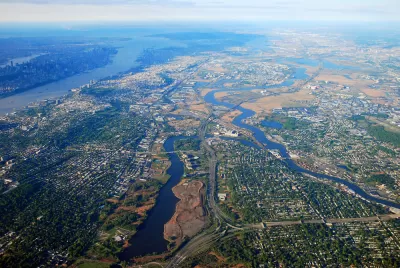A new book outlines the benefits of public investment at the regional scale.

A new book from the Lincoln Institute by Robert D. Yaro, Ming Zhang, and Frederick R. Steiner examines the role of 'megaregions' in shaping the future of U.S. policy and planning. As Will Jason writes, "Megaregions and America’s Future explains the concept of megaregions, provides updated economic, demographic, and environmental data, draws lessons from Europe and Asia, and shows how megaregions are an essential framework for governing the world’s largest economy."
Geared to urban and regional planners and policy analysts, staff and decision makers in transportation, environmental protection, and development agencies, faculty and students in related fields, as well as business leaders, Megaregions and America’s Future includes a case study of the Northeast—the nation’s oldest megaregion and the source of the concept—but delves deeply into every megaregion, from the Great Lakes to the Gulf Coast to Southern California.
The authors argue that a regional approach is more appropriate for large-scale issues such as sea level rise or high-speed rail that require action across a broad geographic area. According to the book, megaregions are "the perfect geographic unit for channeling federal investment and managing large systems such as interstate rail, multistate natural resource systems, climate mitigation or adaptation, and major economic development initiatives."
FULL STORY: New Book on Megaregions Provides a Framework for Large-Scale Public Investment

Maui's Vacation Rental Debate Turns Ugly
Verbal attacks, misinformation campaigns and fistfights plague a high-stakes debate to convert thousands of vacation rentals into long-term housing.

Planetizen Federal Action Tracker
A weekly monitor of how Trump’s orders and actions are impacting planners and planning in America.

Chicago’s Ghost Rails
Just beneath the surface of the modern city lie the remnants of its expansive early 20th-century streetcar system.

Bend, Oregon Zoning Reforms Prioritize Small-Scale Housing
The city altered its zoning code to allow multi-family housing and eliminated parking mandates citywide.

Amtrak Cutting Jobs, Funding to High-Speed Rail
The agency plans to cut 10 percent of its workforce and has confirmed it will not fund new high-speed rail projects.

LA Denies Basic Services to Unhoused Residents
The city has repeatedly failed to respond to requests for trash pickup at encampment sites, and eliminated a program that provided mobile showers and toilets.
Urban Design for Planners 1: Software Tools
This six-course series explores essential urban design concepts using open source software and equips planners with the tools they need to participate fully in the urban design process.
Planning for Universal Design
Learn the tools for implementing Universal Design in planning regulations.
planning NEXT
Appalachian Highlands Housing Partners
Mpact (founded as Rail~Volution)
City of Camden Redevelopment Agency
City of Astoria
City of Portland
City of Laramie




























